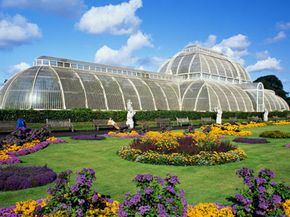Greenhouse Styles
Working greenhouses are built with function in mind and usually lack the style and detail of conservatories and sunrooms. Functional greenhouses are designed to take advantage of the available sun and heat, provide ventilation and allow enough area for planting and maintenance. The structures are typically lightweight, simple and efficient.
Lean-to: One of the least expensive greenhouse styles, lean-tos are sometimes called half-greenhouses because they look like a house that's been cut in half, straight down the middle. Lean-tos are attached to other buildings for support and share a common wall, which provides additional heat and shelter. Although lean-tos usually have lower material costs and may have the advantage of being close to electricity and water, they're limited in size by the supporting wall of the adjacent building. They also need to be carefully situated in order to take full advantage of the available light.
Advertisement
Freestanding: Positioning a greenhouse away from other structures can be a sensible way to maximize the light from all sides. Depending on the area, this can be important in autumn, or when the sky is overcast. Although freestanding greenhouses come in a number of different styles, like a-frames, span roof and Quonset, material costs and access to water and a supplemental heat source are important considerations. Commercial growers often erect large freestanding greenhouses end-to-end to maximize efficiency and limit heat loss.
Decorative: Decorative greenhouses or conservatories have a long and romantic past. In the 19th century, they were widespread and represented wealth and refinement. To this day, decorative enclosures that bring the outdoors in, like sunrooms and enclosed decks, are very popular for their aesthetic value both in private homes and public buildings.
Cold Frames and Other Structures: You can make a greenhouse wherever you have light and can circulate the air. This can be convenient because it's easy to make temporary greenhouse-like structures that can get seeds started long before the last frost and then be put away until the following spring. Greenhouses can be small or large, incorporate a deep window, a jar or even an inverted plastic tub -- with a little modification.
Next we'll look at the different parts of a greenhouse and why they're important.
